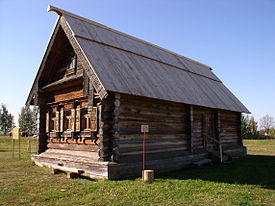Izba
It is generally built close to the road and inside a yard, which also encloses a kitchen garden, hay shed, and barn within a simple woven stick fence.
Both interior and exterior are of split pine tree trunks, the gap between is traditionally filled with river clay, not unlike the North American log cabin.
Coins, wool, and frankincense were customarily placed beneath the corners of the house as an expression of the superstition that doing this would make the people living there healthy and wealthy.
From the fifteenth century on, the central element of the interior of izba was the Russian stove, which could occupy up to one quarter of the floorspace in smaller dwellings.
According to historian of Russia Geoffrey Hosking, starting in the eighteenth century khata was used in to refer to cottages on the tree-poor southern steppes which used logs only for the framing, and then used wattle-and-daub as infill covered with a plaster and whitewash exterior.


